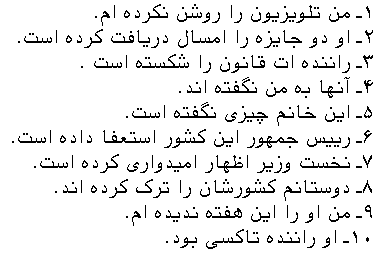As you know, practice makes perfect! These useful drills present even more words and phrases than covered in this week’s lesson. This will not only build your Persian vocabulary, but also help you learn to read and write Farsi more quickly and confidently.
Note: Before doing these homeworks, make sure you have learned the previous words fluently.
New words:
To receive = ![]() /dærya:ft kærdæn/.
/dærya:ft kærdæn/.
To tell somebody = ![]() /beh somebody goftæn/.
/beh somebody goftæn/.
President = ![]() /ræi:s-e- jomhu:r/.
/ræi:s-e- jomhu:r/.
Also /ræi:s jomhu:r/, without /-e-/ sound.
Estefa dadanPrime minister = ![]() /nækhost væzi:r/.
/nækhost væzi:r/.
To express hope = /ez ha:r-e- omidva:ri kærdæn/.
Taxi driver = /ra:nændeh ye ta:ksi/.
Please translate the following sentences into Persian.
- I haven’t turned on the TV.
- She has received two awards this year.
- Your driver has broken the law.
- They haven’t told me.
- This lady hasn’t said anything.
- The president of this country has resigned.
- The prime minister has expressed hope.
- My friends have left their country.
- I haven’t seen her this week.
- He was a taxi driver.

pervez
May 3, 2012 @ 9:04 am
in lesson 31 drills ,why raa has not been used in sentense no.6 after kiswar.any body please explain.regards
Hassan H
May 3, 2012 @ 9:29 pm
i think i should talk about ‘ra’ again in a separate lesson (many students are struggling with this).
i don’t know when, but i will definitely do this in the future.
thanks.
Brian
December 7, 2012 @ 10:23 pm
Hi, Pervez. The answer is simpler than it might appear at first. Ra is used only with direct objects. If you break the sentence down, keshvar is not a direct object. When you say “The president of this country has resigned,” country is not a direct object of “has resigned,” and therefore will not receive a ra. I hope this helps.
codejamer1
July 7, 2013 @ 3:24 pm
When does ‘daadan’ come at the end of a verb in Persian?
And when does ‘Kardan’ come at the end of a verb?
mohammad mj
July 16, 2015 @ 10:10 pm
may I ask a silly question?where’s the “useful drills” page of the previous lesson(30)?when I click on it I find myself in the “Persian samples” page.has it been removed or something?
Aamir Suhail
February 5, 2016 @ 6:58 am
Thanx Hassan!!!
Ur work is really priceless…..!
I have a question…
Why in sentence 3 we have “ast” at last but in sentence 8 we have “anad”….i think here also it should be ast….
Gul e Rehna
June 27, 2016 @ 4:33 am
why dostanam used in sentence 8 ??? I think there should be used dostham? am I correct?plz tell me
Bart Haerens
September 21, 2016 @ 4:59 pm
some nouns have different plural endings: http://persiandee.com/view/showLesson/currentLesson/1
Élise
December 29, 2016 @ 5:11 pm
it hasn’t been introduced before, but dust’s plural form is dustan, not dustha.